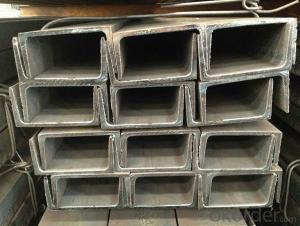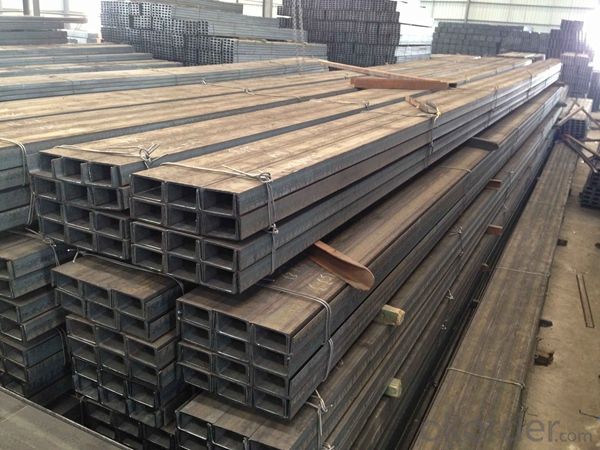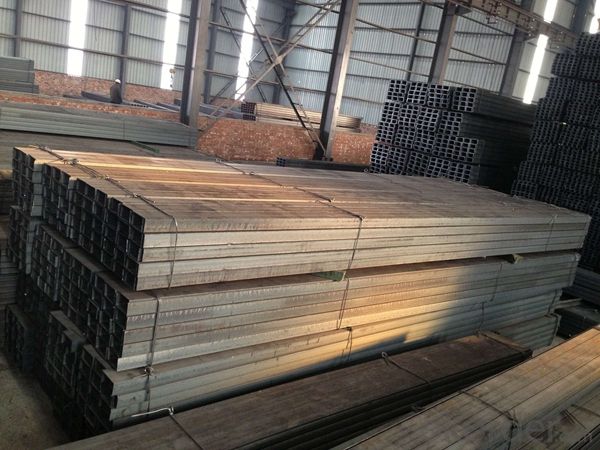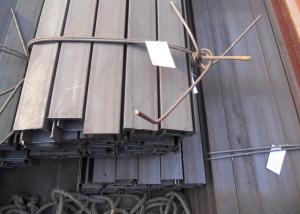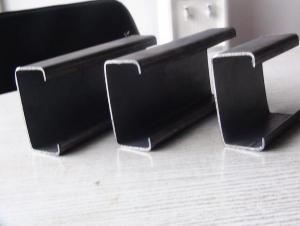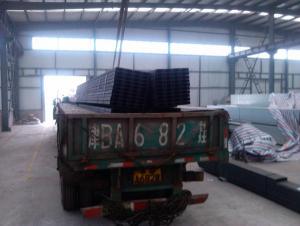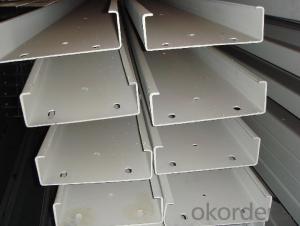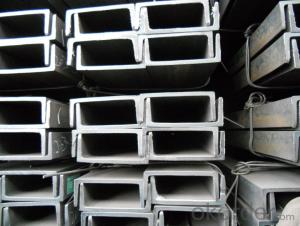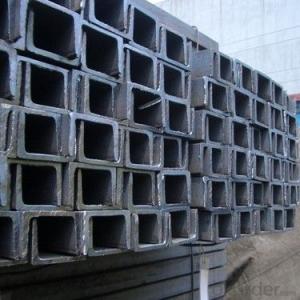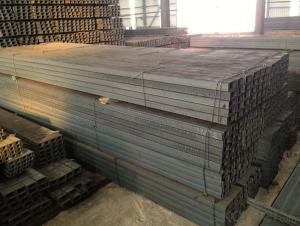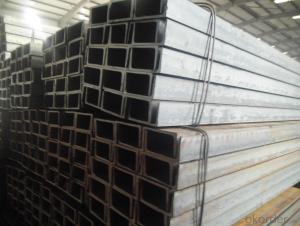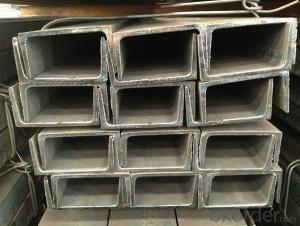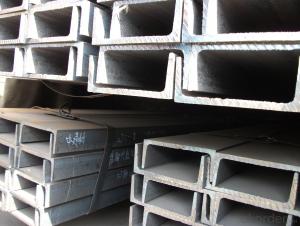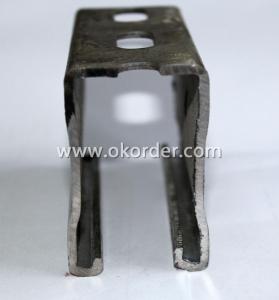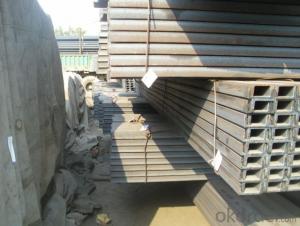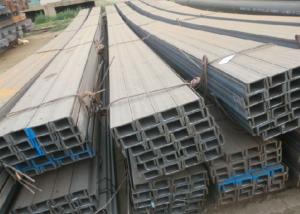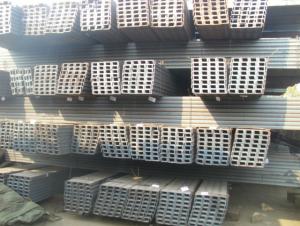Hot Rolled Mild JIS Standard U Channel for Structure Construction
- Loading Port:
- Tianjin
- Payment Terms:
- TT or LC
- Min Order Qty:
- 25 m.t.
- Supply Capability:
- 200000 m.t./month
OKorder Service Pledge
OKorder Financial Service
You Might Also Like
Product Description:
OKorder is offering Hot Rolled Mild JIS Standard U Channel for Structure Constructionat great prices with worldwide shipping. Our supplier is a world-class manufacturer of steel, with our products utilized the world over. OKorder annually supplies products to European, North American and Asian markets. We provide quotations within 24 hours of receiving an inquiry and guarantee competitive prices.
Product Applications:
Hot Rolled Mild JIS Standard U Channel for Structure Construction are ideal for structural applications and general fabricating. The steel u channel can be applied to construction of warehouses, workshops, sport stadiums and car parks etc. In details, the steel u channel belongs to carbon structural steel which is applied to in the field of construction and machinery. The steel u channel is usually used for arch-itechtural structure, and they could be welded in order to support or hang a vari-ety of facilities. They are also usually used in combination with I beam. Generally,the steel u channel must possess perfect welding property, riveting property and mechanical property and so on.
Product Advantages:
Hot Rolled MS Mild JIS Steel U Channels for Strcutures are durable, strong, and resists corrosion.
Main Product Features:
· Premium quality
· Prompt delivery & seaworthy packing (7-10 days after receiving deposit)
· Corrosion resistance
· Can be recycled and reused
· Mill test certification
· Professional Service
· Competitive pricing
Product Specifications:
1.We supply Hot Rolled Mild JIS Standard U Channel for Structure Construction at reasonable price, including Chinese standard, Japanese standard and so on.
Standard | GB/JIS |
Material Grade | Q235,SS400 |
Technique: | Hot Rolled |
Sizes as per chinese standard: | 50*37*4.5mm - 300*89*11.5mm
|
Sizes as per japanese standard: | 50*25*3mm – 200*80*7.5mm |
Length: | 6meter, 9meter, 12meter |
Note: 1.we are also competent to provide our customers other MS Channel based on other sizes according to customer’s requirements.
2. The length of our ms channel could be cut into other meters as per customer’s requirements. For example, the channel in 6meters could be cut into 5.8meters in order to be fit in the 20ft container.
2. The detailed sections of Hot Rolled Mild JIS Standard U Channel for Structure Construction as per GB standard.are shown in the table-
1:
GB U CHANNEL | Standard | Sectional | Dimension |
| Mass: |
(mm) | (mm) | (mm) | (mm) | ||
50X37 | 50 | 37 | 4.50 | 7.0 | 5.438 |
63X40 | 63 | 40 | 4.80 | 7.5 | 6.634 |
80x43 | 80 | 43 | 5.00 | 8.0 | 8.045 |
100x48 | 100 | 48 | 5.30 | 8.5 | 10.007 |
120x53 | 120 | 53 | 5.50 | 9.0 | 12.059 |
140x58 | 140 | 58 | 6.00 | 9.5 | 14.535 |
140x60 | 140 | 60 | 8.00 | 9.5 | 16.733 |
160x63 | 160 | 63 | 6.50 | 10.0 | 17.240 |
160x65 | 160 | 65 | 8.50 | 10.0 | 19.752 |
180x68 | 180 | 68 | 7.00 | 10.5 | 20.174 |
180x70 | 180 | 70 | 9.00 | 10.5 | 23.000 |
200x73 | 200 | 73 | 7.00 | 11.0 | 22.637 |
200x75 | 200 | 75 | 9.00 | 11.0 | 25.777 |
220x77 | 220 | 77 | 7.00 | 11.5 | 24.999 |
220x79 | 220 | 79 | 9.00 | 11.5 | 28.453 |
250x78 | 250 | 78 | 7.00 | 12.0 | 27.410 |
250x80 | 250 | 80 | 9.00 | 12.0 | 31.335 |
250x82 | 250 | 82 | 11.00 | 12.0 | 35.260 |
280x82 | 280 | 82 | 7.50 | 12.5 | 31.427 |
280x84 | 280 | 84 | 9.50 | 12.5 | 35.823 |
280x86 | 280 | 86 | 11.50 | 12.5 | 40.219 |
300x85 | 300 | 85 | 7.50 | 13.5 | 34.463 |
300x87 | 300 | 87 | 9.50 | 13.5 | 39.173 |
300x89 | 300 | 89 | 11.50 | 13.5 | 43.883 |
Table-1
3. The chemical composition of Hot Rolled Mild JIS Standard U Channel for Structure Construction according to Q235B is shown in Table-2.
Alloy No | Grade | Element(%) | ||||
C | Mn | S | P | Si | ||
Q235 | B | 0.12-0.20 | 0.3-0.7 | ≦0.045 | ≦0.045 | ≦0.3 |
Table-2
Note: we are able to present our customers relevant SGS test report for chemical composition of HR Channel Steel.
4. The mechanical property of HR Channel Steel according to Q235B is shown in Table-3-1 and Table-3-2
Alloy No | Grade | Yielding Strength Point(Mpa) | |||
Thickness(mm) | |||||
≦16 | >16-40 | >40-60 | >60-100 | ||
≧ | |||||
Q235 | B | 235 | 225 | 215 | 205 |
Table-3-1
Alloy No | Grade | Tensile Strength(Mpa) | Elongation After Fracture(%) | |||
Thickness(mm) | ||||||
≦16 | >16-40 | >40-60 | >60-100 | |||
≧ | ||||||
G235 | B | 375-500 | 26 | 25 | 24 | 23 |
Table-3-2
Note: we are able to present our customers relevant SGS test report for mechanical property of MS Channel as customer’s request.
Images:

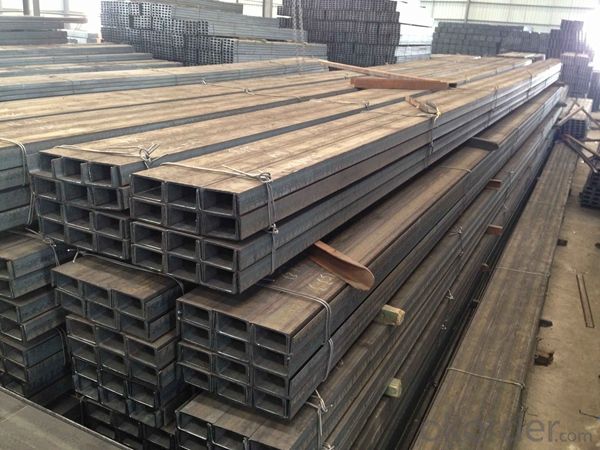
FAQ
Q1: Why buy Materials & Equipment from OKorder.com?
A1: All products offered byOKorder.com are carefully selected from China's most reliable manufacturing enterprises. Through its ISO certifications, OKorder.com adheres to the highest standards and a commitment to supply chain safety and customer satisfaction.
Q2: Can fit in the containers of 20inches the steel beams of 6M?
A2: No proble, we can put them into the containers in the form sideling.
Q3: The products are invoicing on theoritical weight or on actual weight?
A3: We can do it in both manners, according to the customers' request.
- Q: What are the different surface treatments available for steel channels?
- Some of the different surface treatments available for steel channels include galvanizing, powder coating, painting, and epoxy coating. Galvanizing involves applying a protective layer of zinc to the surface of the steel, providing corrosion resistance. Powder coating involves applying a dry powder to the surface of the steel, which is then heated and cured to create a durable and decorative coating. Painting involves applying liquid paint to the steel surface, providing both protection and aesthetics. Epoxy coating involves applying an epoxy resin to the steel surface, which creates a durable and chemically resistant coating.
- Q: Channel structure, angle steel, I-beam and so on, if not painted, the impact on life?
- Influence, without paint, easy to rust, will reduce life, strength will be affected.
- Q: What are the different methods of protecting steel channels from rust?
- There exist various methods for safeguarding steel channels against rust. 1. Galvanization: A widely employed technique entails coating the steel channels with a layer of zinc. This zinc coating acts sacrificially, shielding the steel from corrosion. Galvanized steel channels exhibit high resistance to rust, even in harsh surroundings. 2. Powder coating: This method involves the application of a dry powder onto the steel channel's surface, followed by heating to generate a protective layer. Powder coating offers exceptional corrosion resistance and an assortment of color options. 3. Application of paint or primer: By applying a layer of paint or primer to the steel channels, one can protect them against rust. The paint forms a barrier between the steel and its environment, preventing moisture and oxygen from reaching the metal surface. 4. Epoxy coating: Industrial settings often employ epoxy coatings to safeguard steel channels from corrosion. These coatings possess excellent adhesion, chemical resistance, and durability, thus providing long-lasting protection against rust. 5. Stainless steel: Opting for stainless steel channels proves an effective means of rust prevention. Stainless steel comprises a significant percentage of chromium, which creates a passive protective layer on the surface, rendering it highly resistant to corrosion. 6. VCI (Volatile Corrosion Inhibitors): VCI films or papers can be utilized to wrap or line steel channels. These materials emit vapor-phase corrosion inhibitors, safeguarding the metal surface from rust. 7. Cathodic protection: This approach involves connecting the steel channels to a sacrificial anode, such as zinc or magnesium. The anode corrodes instead of the steel, thereby protecting it from rust. Selecting the appropriate method relies on the specific environment, budget, and desired level of protection. Regular maintenance and inspection of the steel channels are crucial for detecting any signs of corrosion and taking necessary preventive measures.
- Q: Can steel channels be used in load-bearing walls?
- Yes, steel channels can be used in load-bearing walls. Steel channels are commonly used for structural support in construction projects due to their high strength-to-weight ratio. They are often employed in load-bearing walls to provide additional support and stability. Steel channels offer excellent load-bearing capabilities, as they can withstand heavy vertical and horizontal loads. Additionally, they can be easily integrated into the wall structure, making them a practical choice for load-bearing applications. However, it is important to consult with a structural engineer or a construction professional to ensure that the specific steel channels being used meet the required load-bearing capacities and comply with building codes and regulations.
- Q: Can steel channels be used for framing door and window openings?
- Yes, steel channels can be used for framing door and window openings. Steel channels provide a strong and durable support structure that can effectively handle the weight and stress of doors and windows. They offer stability and resistance to deformation, making them suitable for framing openings in residential, commercial, or industrial buildings. Additionally, steel channels can be easily customized and cut to the required dimensions, allowing for flexibility in design and construction.
- Q: What is the cost of steel channels compared to other materials?
- The price of steel channels can vary based on several factors, including the type and grade of steel, market demand, and location. Generally, steel channels are more expensive than materials like wood or aluminum, but they can be more cost-effective than stainless steel or titanium. Steel channels have numerous advantages that justify their higher cost. They are known for their strength, durability, and corrosion resistance, making them suitable for various applications in construction, manufacturing, and infrastructure projects. Steel channels also have excellent load-bearing capabilities, allowing them to support heavy loads and withstand extreme conditions. Furthermore, steel channels are readily available in standard sizes and can be easily obtained from local suppliers or manufacturers. This accessibility contributes to lower transportation costs compared to materials that may need to be imported. It is important to note that the cost of steel channels can also be influenced by market fluctuations, such as changes in raw material prices or tariffs. Therefore, conducting thorough research and obtaining quotes from different suppliers is essential to accurately understand the current cost of steel channels in relation to other materials.
- Q: Can steel channels be used in interior design applications?
- Yes, steel channels can be used in interior design applications. Steel channels are versatile and durable, making them suitable for a variety of design purposes. They can be used as structural elements, decorative accents, or even functional features in interior spaces. Steel channels can be creatively incorporated into architectural details such as room dividers, wall paneling, shelving units, and furniture pieces. Their sleek and modern appearance adds an industrial and contemporary touch to any interior design style. Additionally, steel channels can be customized in terms of size, finish, and shape to meet specific design requirements, making them a flexible choice for interior designers.
- Q: If there is a cylinder, the diameter is about 1000mm, height is about 1000mm, similar to the kind of pressure vessel, plate thickness 6mm 304 of stainless steel, want to use 4 channel steel leg support, how big is appropriate? How do you calculate it?
- What's in the pressure vessel?Calculate the weight, each channel bear 1/4, calculate the required area of A=N/p, and then channel selection.Very simple buddy.
- Q: Can steel channels be used for handrail supports?
- Yes, steel channels can be used for handrail supports. Steel channels are commonly used in construction for their strength and durability, making them an ideal choice for handrail supports. They provide stability and support to the handrail, ensuring its safety and longevity. Additionally, steel channels can be easily customized and fabricated to fit specific handrail designs and requirements.
- Q: Can steel channels be used in interior design?
- Yes, steel channels can definitely be used in interior design. Steel channels, also known as C-channels or U-channels, are versatile and can add a modern and industrial touch to any interior space. They can be used in various ways, such as creating unique shelving units, room dividers, staircases, or even as decorative accents. Steel channels are strong and durable, making them suitable for both functional and aesthetic purposes. They can be left in their natural steel finish for a raw and edgy look, or they can be painted or powder-coated to match any desired color scheme. Overall, steel channels are a great choice for interior design as they offer both functionality and style.
Send your message to us
Hot Rolled Mild JIS Standard U Channel for Structure Construction
- Loading Port:
- Tianjin
- Payment Terms:
- TT or LC
- Min Order Qty:
- 25 m.t.
- Supply Capability:
- 200000 m.t./month
OKorder Service Pledge
OKorder Financial Service
Similar products
Hot products
Hot Searches
Related keywords
